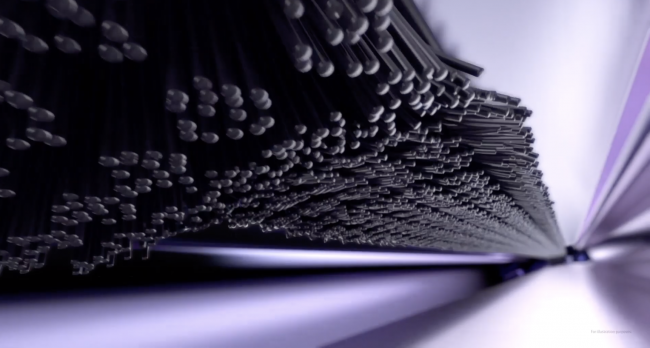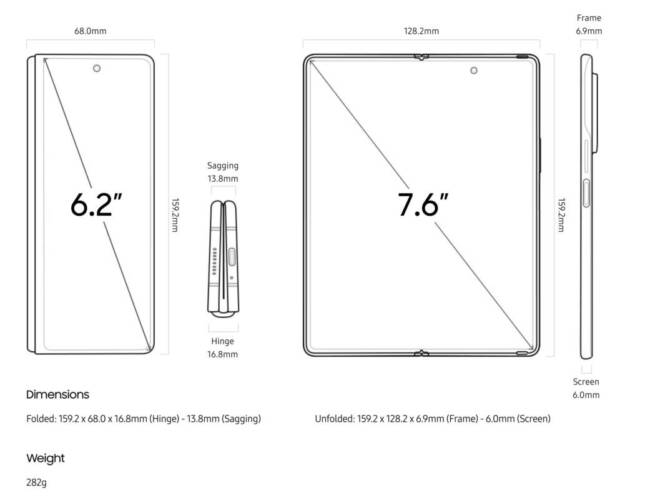If you had told me six months ago that I would be completely enamored with an oversized folding smartphone — a true phablet (phone+tablet) — I would have laughed at you; now, the joke is on me.
I’ve been using an AT&T Samsung Galaxy Z Fold3 for almost two months, and it has redefined everything I’ve ever thought I would ever want in a smartphone. This review will be a long one, which is why I’m splitting it into two parts.

The Galaxy Z Fold3 is the third generation of Samsung’s first-ever folding smartphone; the original was unveiled back in 2019, but its story dates back to more than a decade ago.
I’ve long imagined owning a smartphone that would present as a regular phone but could magically unfold into a full-sized tablet. In the early 2010s, while covering the Consumer Electronics Show, I stumbled upon a booth with a vendor showing off a flexible but not quite bendable glass. It was then when I realized this piece of science fiction might one day become a reality, possibly sooner rather than later.
Even though a genuinely flat-foldable glass isn’t yet available, Samsung didn’t let that stop them on their years-long quest to design and produce their first folding smartphone.
Let’s walk down memory lane for a moment, shall we?
The Tease of a Folding Smartphone Future
As early as 2014, Samsung showed off its first flexible display prototype, accompanied by a vision of phones that would fold in two.
And every year after that, I wondered if the day of actual foldable smartphones one could buy would finally come.
Then, in November 2018, Samsung showed off a working prototype of their new Infinity Flex Display. We would later learn that it was made of “bonded, tissue-thin layers of innovative materials” topped with a polyimide film. In case that’s not clear, this type of display was plastic. While the Infinity Flex Display wasn’t an actual folding glass screen, it was still a leap forward into something interesting.

2019: The Samsung Galaxy Fold
Finally, on February 20th, the Samsung Galaxy Fold was official. Well, sort of. Samsung introduced the phone, accompanied by this video at the Samsung Unpacked event in San Francisco.
The Galaxy Fold was described by Samsung Vice President of Product Marketing, Justin Denison, as a “one of a kind luxury device,” making it immediately evident that this extraordinary phablet wasn’t going to be within most budgets.
After this event, unlike the usual way phone launches go, the Samsung Galaxy Z Fold was not out for the press to handle and photograph; it was behind a glass box.
A week later, at Mobile World Congress in Barcelona, the Samsung Galaxy Z Fold was displayed, but again, it was behind a glass box. This was starting to raise concerns that the phone wasn’t safe to handle or ready for its announced launch date on April 26th.
Preorders for the Samsung Galaxy Z Fold had begun. At that time, the most significant controversy over this new category of folding smartphones beyond its high price and who its actual target market would be was how noticeable the crease was in the center of the main display when users unfolded the phone.
By mid-April, Samsung had sent Galaxy Fold devices to a few reviewers for short loan periods; unfortunately, many of the recipients quickly ran into trouble.
Some of the review units didn’t include a warning on the main display to not remove the protective film, so several reviewers found that the seemingly “removeable screen protector” on the main display was actually an integral top layer of the Infinity Flex Display. When the “screen protector” was even partially removed, the Fold’s main display became non-functional. But you didn’t have to remove the display’s top layer for there to be problems; debris could easily get under the flexible display, causing its own set of issues.
With that, Samsung collected their review units and halted the April 2019 release to reassess and refine. Samsung and retailers that had agreed to sell the new device — including AT&T and Best Buy — began to issue refunds on the preorders.
It was back to the drawing board for Samsung.
To address the issues found on the early devices, Samsung extended the protective top layer of the main display so it could no longer be mistaken for a removable factory screen protector. They added a noticeable care instructions overlay on the main display that you couldn’t miss when opening the box, telling users how to protect the device and clearly saying not to remove the protective top layer on the top of the display.
Further improvements included metal reinforcements under the main display to strengthen it and try to make the center of the device’s folding center (aka, the crease) less obvious. Samsung added protective end caps on each end of the main display’s folding center to help keep dust and debris out, and the hinge’s gap was reduced.
The Samsung Galaxy Fold was ultimately released on September 27, 2019.
While many of the original Galaxy Fold reviewers had liked the idea of a smartphone that they could unfold into a 7.3″ tablet, nearly every single review listed cons including that the hybrid smartphone/tablet was too heavy and bulky and that for its price, the Galaxy Fold was way too fragile. The 4.6″ cover display was deemed too small to be functional, the nearly 1.5″ long by 0.25″ tall camera notch on the main display was unnecessarily large and distracting, the fingerprint reader under the power button could be hard to access, and the crease in the center of the plasticky-feeling main display was a bit too obvious.

The first generation Samsung Galaxy Z Fold specifications
There were also plenty of valid concerns about the Galaxy Fold’s plastic main display’s durability and how it would hold up over time. People who owned one for longer than a month complained that the main display’s top layer was too easily scratched. With the cover display being almost unusably small, you had to use the main display, but opening the phone to view apps there didn’t always work well because many apps wouldn’t correctly scale. On top of that, the Galaxy Fold had no IP dust or water resistance whatsoever.
Long story short, the $1980 Galaxy Fold was a costly device that wouldn’t be obtainable or practical for most smartphone users. Considering that it likely couldn’t survive a drop onto anything hard, it was almost too delicate for daily use.
But as a proof of concept, it was a success, and Samsung didn’t stop there.
2020: The Galaxy Z Flip Introduces Ultra-Thin Glass (UTG) and the Hideaway Hinge to Their Folding Smartphones
In February 2020, Samsung announced the $1400 Galaxy Z Flip. The Galaxy Z Flip used a next-generation display made of what Samsung called Ultra-thin Glass (or UTG) on the Galaxy Z Flip’s 6.7″ main display. It was composed of a thin sheet of bendable 30-micron-thick glass reinforced with a non-removable polymer protector. Even so, there was some controversy as to whether the UTG was actually even glass. It is, but where the technology is today, it must be incredibly thin to make glass foldable, which requires a non-removable polymer protector to help keep its integrity.
The result UTG display felt less plasticky, and fingertips could more easily glide on it. Even better, the crease in the center of the display didn’t seem quite as obnoxious. The Galaxy Z Flip finally introduced a folding smartphone that looked and felt like the aspirational device it was meant to be. While it wasn’t the phablet we’d been waiting for, it was another step in the right direction.

The Samsung Galaxy Z Flip and Galaxy Z Flip 5G specifications
The Galaxy Z Flip also introduced Samsung’s new Hideaway Hinge, which could hold itself open in any position; sweeper technology had been created to help keep debris from getting under the main display.

Sweeper technology in the Hideaway Hinge
I went into an AT&T store after the Galaxy Z Flip was available, and I was surprised to see it on an open display next to a Galaxy Fold. The store had not had Galaxy Fold’s in stock before when I had been in looking for one. Now I was able to compare the builds on both devices, and the look and feel of the Infinity Flex Display on the Galaxy Fold versus the UTG Display on the Galaxy Z Flip at the same time.
It was shocking to me to see how plasticky and unsophisticated the Galaxy Fold’s display felt compared to the Galaxy Z Flip’s UTG display. The tiny punch-hole camera on the Galaxy Z flip’s display next to the overlarge notch on the Galaxy Fold’s display made the two devices seem like they were years apart rather than only a few months.
While the advances made in the Galaxy Z Flip made me hopeful for the next generation Samsung Galaxy Fold devices, I couldn’t help but feel that anyone who had bought a Galaxy Z Fold had to be understandably upset that they hadn’t waited.
2020: The Samsung Galaxy Z Fold2
Then, in September 2020, Samsung released the $2000 Galaxy Z Fold2, which brought all of the company’s folding smartphones under Samsung’s new Z series and addressed many of the issues early adopters had encountered with the original Galaxy Z Fold. The Galaxy Z Fold2 introduced Ultra-thin Glass to the Z Fold line, a larger 7.6″ main display, and it brought an even more refined Hideaway Hinge than the one the Galaxy Z Flip had used.
Samsung replaced the distracting, overlarge camera notch on the main display with a small punch hole camera. Perhaps the most welcome improvements were the larger and much more usable 6.2″ display on the front cover, software improvements that made apps scale better on the main display, and the fingerprint reader integration into the right side power button.

The Samsung Galaxy Z Fold2’s specifications
Even though the Galaxy Z Fold2 proved to be surprisingly durable, users still encountered some issues, including reports that the factory-installed screen protector on the main display could start bubbling in the crease within just a few months after the phone’s release. Proving that there was no way to make everyone happy, there were even complaints that the much smaller punch-hole camera on the main display, which had replaced the oversized notch, was an “eye sore” on the otherwise glorious main display.
Even so, the Samsung Galaxy Z Fold2 seemed to be getting very good ratings overall, with the main complaints still revolving around it being more expensive than the original Galaxy Fold’s price, its bulkiness, and the continued lack of water resistance.
2021: The Samsung Galaxy Z Fold3
In August 2021, Samsung announced the latest generation of their folding smartphones. The new Galaxy Z Fold3 would have similar dimensions to the Galaxy Z Fold2, but it was a little lighter and a little more svelte. Most importantly, however, Samsung had achieved significant upgrades to the design and durability.
The Galaxy Z Fold3’s frame is made with Samsung’s new Armor Aluminum, which they are calling the “strongest aluminum ever used on a Galaxy smartphone.” Corning Gorilla Glass Victus is again used on its glass front and back to protect the device from scratches and drops. The main screen now has optimized panel layers, with a new protective film made of PET (polyethylene terephthalate) that Samsung says is 80% more durable than their previous folding devices.
The successful Hideaway Hinge is back, but it is now even thinner and less obtrusive. The sweeper technology used on the Hideaway Hinge is still present; in the Unpacked event, Samsung announced that they had enhanced the previous-generation Hideaway Hinge with even shorter bristles to help repel dust and pocket detritus. But perhaps most importantly, the Galaxy Z Fold3 now has IPX8 water resistance (protection against submersion in up to 1.5 meters of fresh water for up to 30 minutes).
With that said, there’s still no stated dust resistance, with Samsung noting that “these devices are not dust-resistant. Exposure to small particles, such as sand, may cause damage to the device, such as scratches or dents on the screen” and that the phone is “not advised for beach or pool use.”
During the Samsung Galaxy Z Fold3 event, many of us were pleased to see that the price for Samsung’s premier folding device had finally dropped a little bit; you can now get a Galaxy Z Flip3 with 12GB RAM with 256GB for $1800 or one with 12GB RAM with 512GB user memory for $1900. Owning a Z Fold3 is still not inexpensive, but with Samsung, AT&T, and other carriers offering up to $1000 off with device trade-ins and carriers’ monthly payment plans, it’s finally a bit more within reach.

The Samsung Galaxy Z Fold3’s specifications
